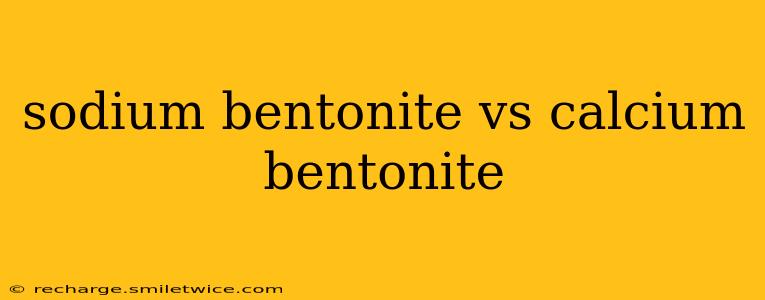Bentonite clay, a versatile material with diverse applications, comes in various forms, most notably sodium bentonite and calcium bentonite. While both originate from the same volcanic ash source, their distinct chemical compositions lead to significant differences in properties and suitability for different uses. This article will delve into the key distinctions between sodium and calcium bentonite, helping you understand which type best suits your needs.
What is the difference between sodium and calcium bentonite?
The primary difference lies in the cation (positively charged ion) dominating the clay's structure. Sodium bentonite has sodium ions as its dominant cation, while calcium bentonite has calcium ions. This seemingly small difference dramatically alters their swelling capacity, viscosity, and overall performance characteristics.
What are the properties of sodium bentonite?
Sodium bentonite is characterized by its exceptional swelling capacity. When exposed to water, it absorbs a significant amount of liquid, expanding considerably. This swelling property is crucial for its use in applications requiring high viscosity and gel-forming capabilities. Other key properties include:
- High Swelling Capacity: This is its most defining feature, allowing it to create thick, gel-like suspensions.
- High Viscosity: Forms highly viscous fluids even at low concentrations.
- Excellent Thixotropy: This means it thins when agitated and thickens when at rest.
- Strong Gel Strength: Creates strong, stable gels.
What are the properties of calcium bentonite?
Calcium bentonite, in contrast, has a much lower swelling capacity than its sodium counterpart. It doesn't expand as dramatically in water and forms less viscous suspensions. However, it possesses other advantageous properties:
- Lower Swelling Capacity: Expands less than sodium bentonite.
- Lower Viscosity: Forms less viscous fluids.
- Higher Permeability: Allows for better water flow.
- Greater Strength when Dry: Forms stronger, more cohesive dry structures.
What are the uses of sodium bentonite?
The superior swelling and viscosity of sodium bentonite make it ideal for various applications, including:
- Drilling Fluids: In oil and gas exploration, it forms the base of drilling muds, helping to lubricate the drill bit and remove cuttings.
- Foundry Bonding: It acts as a binder in foundry sand, holding the sand grains together during casting.
- Wastewater Treatment: Its high adsorption capacity helps remove contaminants from wastewater.
- Pharmaceuticals: Used as a binder and suspending agent in various medications.
- Cat Litter: Its absorbency makes it a common ingredient in cat litter.
What are the uses of calcium bentonite?
While not as versatile as sodium bentonite, calcium bentonite finds its niche in applications where its lower swelling capacity and higher permeability are advantageous:
- Wine Filtration: Used to clarify wine by removing solids.
- Soil Amendment: Can improve soil structure and water retention, although less dramatically than sodium bentonite.
- Animal Feed: Can be used as a binder and flow agent in animal feed.
- Construction Materials: Utilized in certain types of bricks and tiles.
Which type of bentonite is better?
There's no single "better" bentonite. The optimal choice depends entirely on the specific application. If you need high swelling, viscosity, and gel strength, sodium bentonite is the clear winner. However, if lower swelling, better permeability, and greater dry strength are needed, calcium bentonite is a more suitable option.
How is bentonite activated?
Both sodium and calcium bentonite can be further modified through activation processes to enhance specific properties. Activation usually involves treatments that increase surface area and reactivity, leading to improved swelling, viscosity, or other desired attributes. The specific activation method depends on the desired outcome and the type of bentonite.
What is the difference in cost between sodium and calcium bentonite?
The cost difference between sodium and calcium bentonite can vary depending on location, supplier, and purity. Generally, sodium bentonite, due to its higher demand and specialized applications, tends to be slightly more expensive. However, the price difference is usually not substantial enough to significantly impact the overall cost of a project.
This comprehensive comparison of sodium and calcium bentonite highlights their unique properties and applications. By understanding these differences, you can make informed decisions when selecting the appropriate type of bentonite for your specific needs. Remember to always consult with a supplier to determine the best grade and quality of bentonite for your particular application.
